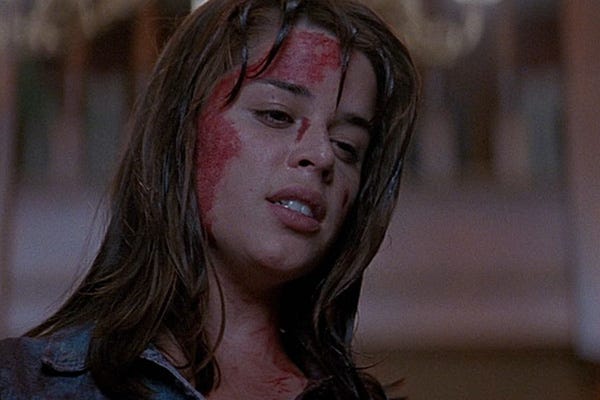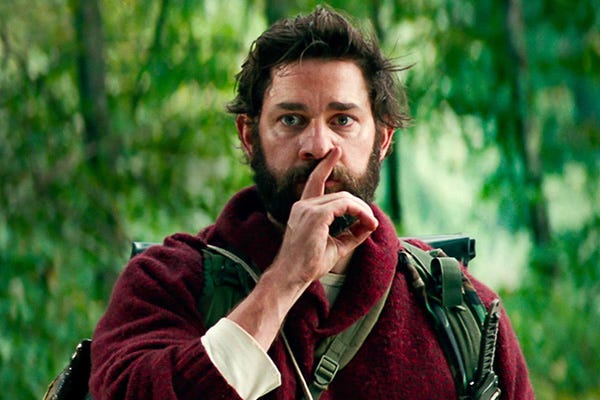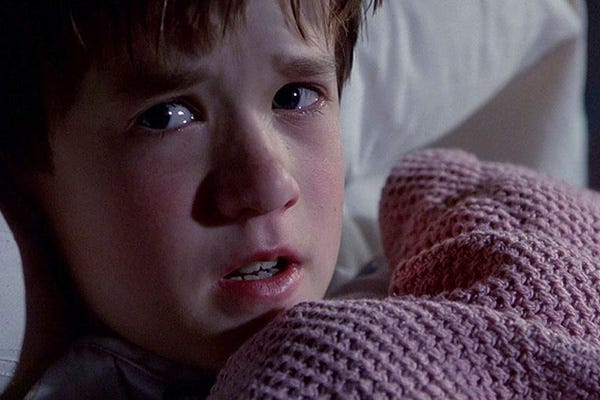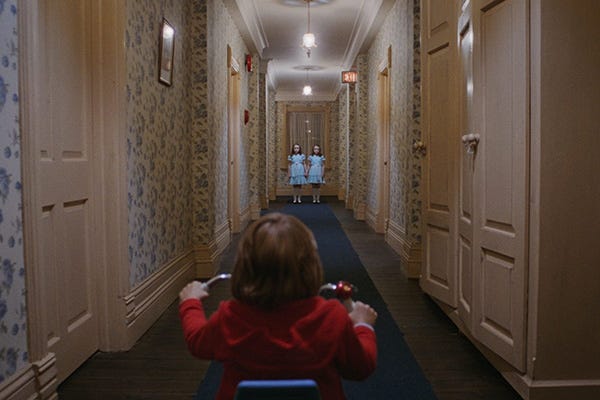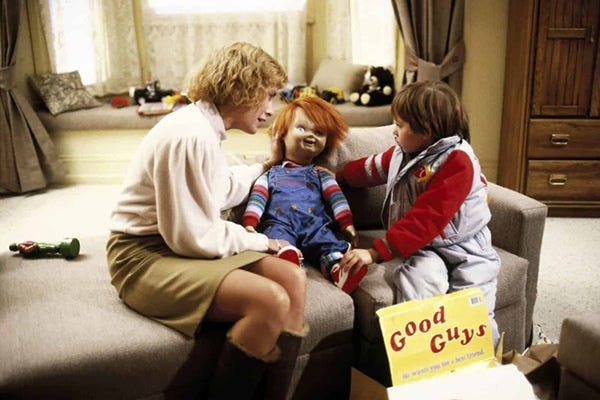Final Girls and Creepy Dolls: Scary Film Tropes That Keep Us Vigilant
Don’t go in there! (They always go in there.)
Tropes are storytelling devices used in all genres to help usher a narrative along. Usually a single film will use a combination of many tropes to create a well-rounded original story, but nevertheless cater to fans who love variations on a particular theme. People who love scary movies might prefer slasher or horror films over psychological thrillers or vice versa. Maybe they live for jump scares or would rather be puzzled by an unreliable narrator. And who doesn’t love a classically shocking twist? We put together a list of just some of the most common scary movie tropes and some examples of where you can find them.
The Final Girl
One of the most known scary movie tropes, the Final Girl is a lone female character that survives the killer throughout the movie, book, or series—and confronts the villain in the climax of the story. Often the Final Girl has a purity about her: she’s someone who usually avoids dangerous situations or reckless behavior and her main characteristic is resourcefulness. Great examples of the Final Girl in films are Halloween’s Laurie Strode, Alien’s Ellen Ripley, and Scream’s Sidney Prescott. Fans of thrillers, horror, and suspense love to discuss the best final girls in film and the trope is often the subject of lively debates and provocative fan-led rankings.
Jump scares
Jump scares can happen in any genre, of course (and also real life experiences like haunted houses and such). But used in a scary movie, they help serve the plot and give the audience the type of experience they signed up for. Paired with sound effects or sharp, ominous music, a jump scare is a sudden loud noise or abrupt movement that comes out of nowhere. It is both expected and unexpected for the viewer, making the entire film tense, keeping you on the edge of your seat. Often a jump scare is meant to distract from the real terrifying scare, which might happen a few moments later. For example, a door slams to scare everyone but it momentarily seems harmless, until the killer steps into the light. One film that highlights jump scares really well is A Quiet Place. Since the entire movie is silent as the characters know that making any noise at all will summon killer aliens, even the smallest noise, like from a child’s toy, serves as a terrifying jump scare. Other movies that utilize the trope well are Insidious, The Conjuring, and The Exorcist.
The bad guy/girl who won’t die
It’s a great trope that either keeps the suspense alive or sets the stage for many sequels in a franchise. We want the hero to kill the villain or make sure they’re gone for good, but sometimes there’s a moment where the assumption of their death is proven untrue and there’s a final climax of the story to come. This often dovetails with another trope: assuming the killer is dead with no proof or confirmation–paving the way for more horror ahead. Great examples of this are Michael Myers in Halloween, Jason Voorhees in Friday the 13th, and Scream.
Unreliable narrator
This trope is used in almost every genre of storytelling, but can be used to drive suspense in a scary movie. It’s more psychological than slasher, and it can be either mind-bending or satisfying to learn the truth at the end of the movie. In The Sixth Sense, the idea of a child seeing dead people is pretty creepy on its own and serves thrills to the viewer–but the reveal in the ending throws the entire plot into question as the audience is forced to reframe everything they just saw. In Shutter Island–spoiler alert–the hero of the movie leading an investigation into a disappearance turns out to be the killer. Gone Girl uses the trope to lull the audience into one story that changes halfway through–and the rest of the book/film is a wild roller coaster from there. Other scary movies that use the trope include One Flew Over the Cuckoo’s Nest and American Psycho, where psychotic delusions from the main character keep the audience guessing what’s real and not. These movies also fall into the “twist ending” trope, a common one in scary films. The unreliable narrator trope is great for rewatching, as viewers can apply their new perspective on subsequent watches.
Don’t go in there!
It’s a classic: you know that your characters should never go into a closet, up some stairs, down a dark hallway, etc. in a scary movie. You will them not to and yell at the screen, chastise them for making stupid choices, and accept that they’ve sealed their own fates, but if you’re being honest with yourself, you want them to: it’s what furthers the plot! The characters are so obviously going to find danger, and thus, it becomes a horror movie. Some great examples of this occur in…well, most creepy movies. But here’s a few that are notable: The Texas Chainsaw Massacre, The Evil Dead, Cabin in the Woods, Halloween, Scream, and Psycho.
Found footage
Found footage is a really powerful trope, because using it pulls viewers into the narrative in a way they might not be otherwise. Presenting amateur-type footage as if it were authentic is far more creepy than watching and knowing that the film is a setup of actors, fake blood, and unreal monsters. But the realism of supposed found footage gives a story more gravitas, even if you know better. There are many ways to present found footage: handheld camera video, cell phone video, video caught by computer cameras or even security footage. This type of storytelling plays with perspective and can either hide details or expose them to the audience depending on the camera in question. While handheld cameras give the narrative a really personal yet focused perspective, a security camera might be more objective–unless it only catches footage in a specific frame. The possibilities are endless. Great examples include The Blair Witch Project, Paranormal Activity, and Cloverfield.
Cute creepy child
The creepy child trope is especially ominous because the child is, well, cute. Innocent-looking children in a scary movie can be incredibly sinister, especially if they have an expressionless look or act in erratic ways; we all saw The Shining and can’t look at a set of adorably dressed twins in a hallway the same way ever again. Cute creepy children in a scary movie have the advantage of their naive looks or charming demeanor; they can potentially manipulate characters–and the viewers–into a false sense of security before carrying out horrifying actions that nobody expected. Or maybe they’re the messengers for evil spirits and monsters–precisely because they’re sweet-looking and less inhibited than adults. In Poltergeist, there’s a reason it’s a little girl who knows first that “they’re heeere.” Other great examples of the cute creepy child trope include The Omen, The Shining, and The Ring.
Possessed doll
The possessed doll trope is somewhat similar to the cute creepy child; something that seems innocent that actually is the bearer of bad news or the perpetrator of bad things. Because dolls are associated with childhood, the effect is similar in scary movies when something is off about them. In this trope, dolls are often turned into vessels of evil or demonic spirits: moving on their own, whispering, or causing harm to those around them. This trope is a classic, scaring generations of kids who watched Child’s Play featuring the murderous Chucky doll and became scared of their toys. Creepy dolls can include all sorts of human-like toys, mannequins or even puppets. Dolls of all kinds have a rich history in human culture, so sometimes an older, weathered doll in a film can be a link to some terrifying past. Conversely, futuristic dolls are equally as creepy. The movie M3gan plays with the idea of artificial intelligence combined with robots, a more modern take on scary inanimate objects that become, well, highly animated and smart. More examples include Annabelle in The Conjuring, Billy in Dead Silence, and the clown doll in Poltergeist.
Everyone splits up
Often paired with the “don’t go in there!” trope, this classic storytelling technique is necessary to separate a scary movie’s victims from safety they might have in numbers. A group of characters facing a threat decide, using shaky logic, to separate. They think it will help them all escape, but actually it makes them much more vulnerable. This often leads to each character being picked off one by one by the killer(s). It’s frustrating and predictable for the viewer, but there’d be no movie if we couldn’t watch the killer hunt down each of the victims one by one in different settings. This allows for multiple storylines and individual scares or isolated confrontations, ensuring the audience remains on edge as each character faces danger alone. It also plays on our fear of helplessness on our own against a threat–making any film far more scary. Some great examples include Halloween, Friday the 13th, The Cabin in the Woods, The Descent and It.
What are your favorite scary movie tropes, and which films use them well? We want to hear all about them in the comments!
Want more? Our Discord is where you’ll find tons of other fans there chatting in our forums about the books, TV shows, movies, music, and games we all love! Don’t forget to follow us on Instagram, tumblr, and Spotify for more fandom content—and hit that subscribe button so you never miss a thing at rmrk*st!




